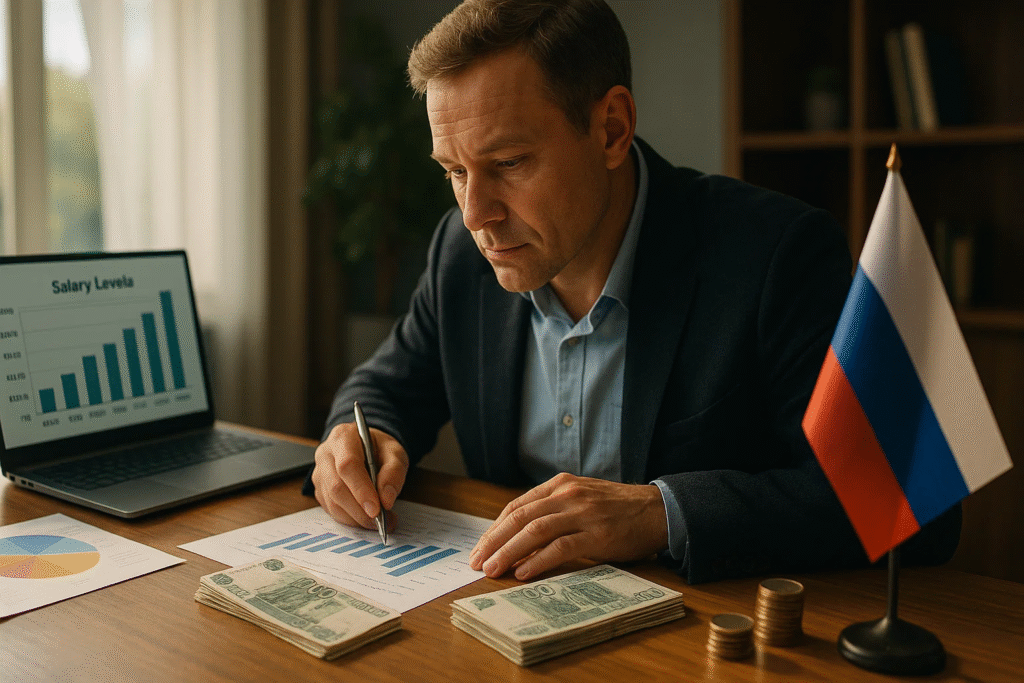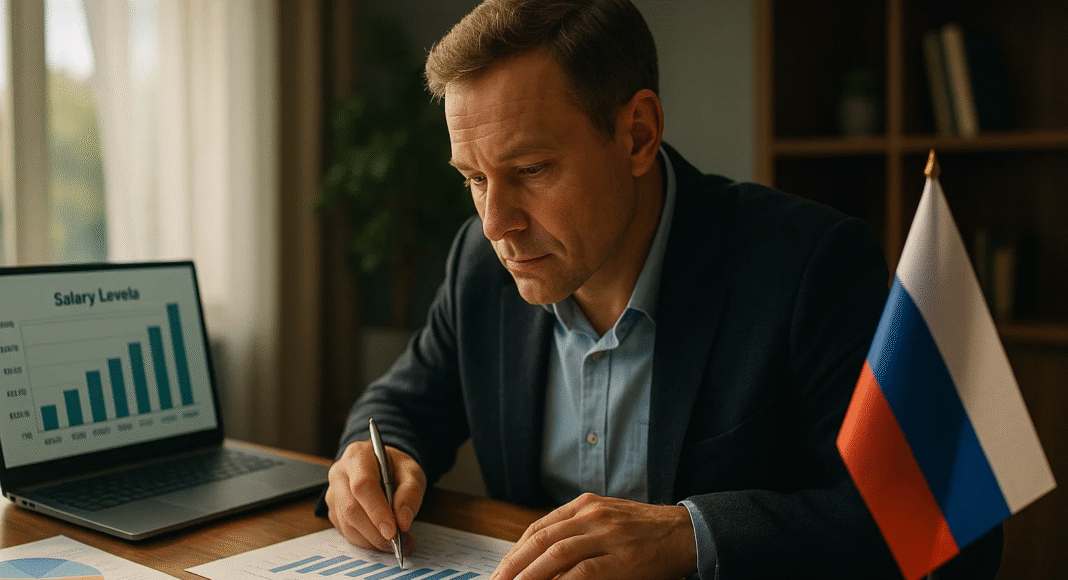Key Takeaways
- Wage Growth Remains Strong: Despite economic slowdown, nominal and real wages in Russia continue to rise due to labor shortages and inflation.
- Industry and Regional Disparities Persist: High-paying sectors like IT and finance contrast sharply with agriculture and rural region salaries.
- Future Outlook Shows Moderation: Salary growth is expected to decelerate post-2025, with real income gains stabilizing amid monetary tightening.
In 2025, understanding salary levels in Russia has become more crucial than ever for businesses, policymakers, and job seekers alike. As the country continues to navigate a complex geopolitical landscape, macroeconomic adjustments, and ongoing transformations in its labor market, analyzing the state of compensation across industries, regions, and occupations provides essential insights into workforce dynamics, living standards, and economic competitiveness. With inflationary pressures, currency fluctuations, labor migration trends, and digital transformation shaping income distribution across sectors, this report delivers a comprehensive and data-driven overview of salary levels in Russia for 2025.

Economic Context Driving Salary Trends in 2025
The Russian economy in 2025 is characterized by a mix of resilience and challenge. While key sectors like energy, defense, IT, and agriculture have remained strong or even expanded due to domestic investment and strategic priorities, sanctions, international trade limitations, and supply chain realignments have caused disruptions in other areas. The government’s increased emphasis on import substitution, local innovation, and digital sovereignty has led to shifts in employment demand and compensation models, particularly in tech, manufacturing, and logistics.
Amidst these developments, wage growth in Russia has varied significantly by industry, region, and job role. Urban centers such as Moscow, St. Petersburg, and Yekaterinburg continue to offer significantly higher salaries than rural or peripheral areas, reflecting economic centralization and greater availability of high-value employment. Additionally, sectors aligned with government strategy—such as cybersecurity, military engineering, and agri-tech—have experienced competitive wage increases, while others, including hospitality and tourism, have seen slower recovery.
Labor Market Dynamics and Workforce Shifts
A defining feature of the Russian labor market in 2025 is its adaptation to both global and domestic pressures. Remote work adoption, digital workforce integration, and a growing freelance economy are reshaping how work is performed and compensated. With younger generations entering the workforce equipped with more technical and digital skills, companies are adjusting salary structures to attract and retain tech-savvy professionals. At the same time, an aging population, regional skill mismatches, and emigration of high-skilled labor have intensified talent shortages in certain fields, further influencing wage scales.
Moreover, governmental policy interventions—ranging from minimum wage adjustments to tax incentives for strategic sectors—are influencing pay equity and labor mobility. The increase in public sector funding, especially in healthcare, education, and defense, has stabilized wages in some traditionally underpaid fields, though disparities remain across regions and industries.
Key Insights Covered in This Analysis
This blog provides a detailed, data-rich analysis of salary levels in Russia for 2025, broken down by key economic sectors, job functions, and geographic regions. It includes:
- Salary benchmarks for key industries such as IT, oil & gas, engineering, retail, finance, logistics, education, and healthcare
- Occupational compensation trends across entry-level, mid-level, and senior-level positions
- Regional salary comparisons between Moscow, St. Petersburg, other major cities, and less urbanized regions
- Impact of inflation, exchange rate fluctuations, and cost of living on real wages and purchasing power
- Trends in remote and freelance work compensation
- Gender wage gap insights and diversity-related pay equity developments
- Government initiatives and labor reforms affecting wage structures and employment law
This in-depth overview will help HR professionals, hiring managers, job seekers, economists, and policy planners gain a clear understanding of where the Russian labor market stands in 2025 and how salaries are evolving in response to economic, political, and social forces.
Strategic Importance of Salary Insights in 2025
Salary intelligence plays a vital role in strategic workforce planning, talent acquisition, and economic forecasting. For multinational companies operating in Russia or considering market entry, accurate and current salary data helps in budgeting, aligning global compensation strategies, and maintaining compliance with local labor standards. For Russian enterprises, these insights are essential to remain competitive, especially in sectors with high turnover or talent scarcity.
For individuals, especially professionals, job seekers, and graduates, understanding salary benchmarks enables better career planning, informed negotiations, and long-term financial security. In an increasingly volatile job market, this data can offer clarity and confidence in making professional decisions.
In the following sections, we will delve deeper into sector-by-sector salary structures, provide regional pay comparisons, and explore the underlying forces shaping income patterns in Russia in 2025. This comprehensive review is designed to offer clarity and actionable insights in a time of transformation for the Russian workforce.
Before we venture further into this article, we would like to share who we are and what we do.
About 9cv9
9cv9 is a business tech startup based in Singapore and Asia, with a strong presence all over the world.
With over nine years of startup and business experience, and being highly involved in connecting with thousands of companies and startups, the 9cv9 team has listed some important learning points in this overview of the Salary Levels in Russia for 2025.
If your company needs recruitment and headhunting services to hire top-quality employees, you can use 9cv9 headhunting and recruitment services to hire top talents and candidates. Find out more here, or send over an email to [email protected].
Or just post 1 free job posting here at 9cv9 Hiring Portal in under 10 minutes.
Salary Levels in Russia for 2025: An In-Depth Analysis
- Economic Foundations Shaping Salary Levels in Russia – 2025 Outlook
- Average Salary Levels in Russia in 2025: A Data-Driven Perspective
- Salary Levels by Industry in Russia – 2025: A Sector-Wise Comparative Analysis
- Salary Levels by Job Role in Russia – 2025: A Detailed Breakdown by Experience and Function
- Regional Differences in Salary Levels in Russia – 2025: A Comparative Geographic Overview
- Key Factors Shaping Salary Levels in Russia – 2025: Economic, Demographic, and Policy Dynamics
- Future Outlook and Trends in Russian Salary Levels – Beyond 2025
- Navigating the Russian Salary Landscape in 2025 and Beyond
1. Economic Foundations Shaping Salary Levels in Russia – 2025 Outlook
An in-depth understanding of Russia’s salary landscape in 2025 must begin with an analysis of its economic underpinnings. Multiple macroeconomic shifts, labor market disruptions, and monetary policy adjustments have reshaped wage structures across sectors. While certain industries exhibit buoyant salary growth, others contend with constraints stemming from inflation, labor shortages, and tightening fiscal policies.
Macroeconomic Climate in Russia – 2025
GDP Growth Trajectory and Structural Headwinds
- Russia’s economic momentum in 2025 is experiencing a moderation phase, diverging from the robust expansion observed during 2023 and 2024.
- GDP growth forecasts range between 0.8% and 2.5%, signaling a deceleration attributed to:
- Elevated interest rates introduced by the Central Bank to combat inflation
- Reduced fiscal stimulus and shrinking government expenditures in non-priority sectors
- Persistent global geopolitical risks and international sanctions
- Weakening private sector demand amid cost pressures
Geopolitical and Trade Constraints
- International sanctions remain a major bottleneck for growth in technology-dependent and export-oriented industries.
- Limited access to foreign capital, critical machinery, and advanced technologies continues to impede industrial scalability and innovation.
- The EBRD and other financial institutions have revised Russia’s growth projections downward in response to:
- Global supply chain fragmentation
- Tariff escalations
- Policy unpredictability in foreign investment flows
Domestic Consumption and Government Spending
Stabilizing Factors for Income and Labor Demand
- Domestic consumption remains a crucial driver for economic activity, supported by:
- Real wage increases in defense and public service sectors
- Targeted government spending on social programs, pensions, and military-industrial expansion
- Government-backed demand in army-related and strategic sectors has elevated salary offers to attract critical talent.
Sector-Specific Wage Impact:
| Sector | Trend in 2025 | Wage Outlook |
|---|---|---|
| Defense Manufacturing | Expanding due to state contracts | High wage growth |
| IT and Cybersecurity | Strategically prioritized | Competitive compensation |
| Hospitality and Tourism | Recovery lagging post-COVID | Sluggish wage movement |
| Retail & FMCG | Impacted by inflation and imports | Moderate wage stagnation |
Inflation and Central Bank Policy Effects
Price Stability Challenges
- Inflation remains elevated, though some metrics indicate slowing pressure.
- Key contributors to inflation include:
- Increased administered prices (public transport, utilities, tariffs)
- Depreciation of the ruble, affecting the cost of imports and consumer goods
Central Bank’s Monetary Response
- The Central Bank of Russia (CBR) has undertaken aggressive monetary tightening:
- Key interest rate elevated to 21% in 2025 to cool inflationary pressures
- Higher borrowing costs weigh on:
- Private sector capital expenditures
- Hiring intentions across SMEs and mid-cap firms
Implications for Wage Growth
- Elevated interest rates:
- Limit private sector salary budget expansions
- Restrain wage hikes outside state-subsidized or strategic sectors
- Encourage fiscal caution in recruitment and HR planning
Labor Market Realities and Wage Pressures
Record-Low Unemployment & Workforce Contraction
- Unemployment has dipped to historic lows of 2.3–2.4% in early 2025
- Key contributors to labor market tightening:
- Mass emigration of skilled professionals
- Military conscription, reducing civilian labor supply
- Escalated demand in military-industrial and public safety sectors
Supply-Demand Mismatch and Wage Escalation
- Ongoing talent shortages are driving intensified competition among employers:
- Wage offers are often inflation-beating to secure essential workforce
- Employers in urban hubs (e.g., Moscow, St. Petersburg, Kazan) provide higher wage incentives than rural counterparts
Expected Stabilization of Wage Growth
- Central Bank surveys indicate a tempering of wage expectations:
- Employers are projecting more conservative salary increases for the remainder of 2025
- Real wage growth is expected to stabilize, rather than spike, as in previous years
Forecast Summary: Wage Drivers in Russia – 2025
| Influencing Factor | Impact on Salaries |
|---|---|
| High interest rates | Suppressed private sector wage expansion |
| Government defense spending | Elevated wages in military-linked industries |
| Ruble depreciation | Cost-push inflation, raising wage demands |
| Labor emigration & conscription | Shrinking talent pool → wage inflation |
| Regional disparities | Urban salaries outpace rural income significantly |
| Policy-driven sector subsidies | Wage growth in targeted industries (e.g. IT) |
Conclusion: Strategic Implications of 2025 Salary Trends in Russia
Salary levels in Russia for 2025 are deeply intertwined with macroeconomic adjustments, demographic shifts, and evolving industrial policy. As the government consolidates its focus on defense, innovation, and digital sovereignty, the compensation landscape will continue to reflect strategic prioritization. Companies must navigate wage competition amidst fiscal tightening, while job seekers face an increasingly segmented labor market with varied wage trajectories depending on region and industry.
Understanding the interplay between inflation, monetary policy, labor supply constraints, and government intervention is essential for forecasting salary benchmarks and making informed employment or investment decisions in Russia’s complex economic terrain.
2. Average Salary Levels in Russia in 2025: A Data-Driven Perspective
As the Russian economy experiences structural and monetary adjustments in 2025, understanding wage movements becomes essential for businesses, labor economists, policymakers, and job seekers. Salary trends across the nation are influenced by inflation dynamics, labor shortages, monetary interventions, and policy-driven wage reforms. This section offers a comprehensive overview of nominal wages, real wages, and minimum wage evolution during the first half of 2025.
Nominal Wage Growth: Indicators of Market Pressure
Nominal wages in Russia — unadjusted for inflation — have shown persistent growth in the early months of 2025, propelled by a tightening labor market and wage competition across sectors.
Key Highlights:
- According to Rosstat (Federal State Statistics Service of Russia):
- January 2025: Average monthly nominal wage stood at 88,981 rubles
- February 2025: Rose to 89,646 rubles, showing continued momentum
- Year-on-Year Nominal Growth:
- 17.1% increase in January 2025 compared to January 2024, driven by:
- Talent shortages in high-demand industries
- Elevated inflation expectations
- Wage pressure from public sector expansion and military-industrial demand
- 17.1% increase in January 2025 compared to January 2024, driven by:
- Forecasts for 2025:
- As per Trading Economics projections:
- Q2 2025: Nominal wages expected to reach 93,157 rubles
- Growth may continue at a tempered pace, as interest rate policy curtails overheated wage surges
- As per Trading Economics projections:
Nominal Wage Trends – 2024 vs 2025 Comparison Table
| Month | Nominal Wage (RUB) | YoY % Growth |
|---|---|---|
| Jan 2024 | 75,996 | – |
| Jan 2025 | 88,981 | +17.1% |
| Feb 2025 | 89,646 | +16.9% (est.) |
| Forecast Q2 2025 | 93,157 | +15-16% (est.) |
Real Wages: Adjusted Earnings Amidst Inflationary Pressures
While nominal wages have risen significantly, real wages—those adjusted for inflation—offer a more accurate measure of workers’ purchasing power and standard of living.
Key Insights:
- January 2025: Real wage growth recorded at +6.5% YoY, reflecting strong purchasing power gains due to:
- Nominal wages rising faster than inflation
- Targeted subsidies and social assistance programs
- February 2025: Real wage growth slowed to 3.2%, suggesting:
- A mild rebound in consumer prices
- Stabilization in wage offers from employers
- Government Forecasts:
- Real wage growth for full-year 2025 projected at approximately +7%
- Assumes sustained nominal increases + moderated inflation control by the Central Bank
Real Wage Movement Chart: Jan–Dec 2025 (Forecasted)
Real Wage Growth Rate (%)
╭────────────────────────────────────╮
│ Jan: 6.5% │
│ Feb: 3.2% │
│ Mar–May: 4.5–5.5% (est.) │
│ Jun–Aug: 6.0–6.8% (est.) │
│ Sep–Dec: 7.0% target (avg.) │
╰────────────────────────────────────╯
Minimum Wage Adjustments: Raising the Floor
To support the nation’s lowest-income earners, the Russian government implemented a significant upward revision of the national minimum wage in 2025.
Key Developments:
- January 2025:
- Minimum wage increased to 22,440 rubles/month
- Up from 19,242 rubles in 2024, marking a +16.6% increase
- Policy Implications:
- Signals a government effort to align minimum income with cost-of-living changes
- Induces a ripple effect in lower-income sectors such as:
- Agriculture
- Retail
- Domestic services
- Could indirectly raise baseline wages in informal and semi-formal labor segments
Minimum Wage Evolution – Year-over-Year Comparison
| Year | Minimum Wage (RUB) | % Increase YoY |
|---|---|---|
| 2023 | 16,242 | — |
| 2024 | 19,242 | +18.5% |
| 2025 | 22,440 | +16.6% |
Synthesis: Impacts of Wage Dynamics on Russian Labor Economics in 2025
| Wage Metric | Status in 2025 | Strategic Interpretation |
|---|---|---|
| Nominal Wages | Rising steadily | Driven by labor shortages and wage competition |
| Real Wages | Improving, but at a slower pace | Inflation-adjusted earnings show moderate growth |
| Minimum Wage | Substantially increased | Reflects policy focus on income equity and welfare |
Conclusion: Evaluating Wage Trajectories in a Volatile Macroeconomic Landscape
The salary levels in Russia during 2025 are emblematic of a labor market under transformation—pressured by inflationary forces but propped up by government intervention and employer-driven competition for scarce talent. Nominal wages are on an upward trend, but their real value is dependent on the successful containment of inflation. Additionally, the upward revision of the minimum wage demonstrates a policy shift toward income redistribution and social stability.
As Russia moves into the second half of 2025, close monitoring of macroeconomic signals, wage indexation policies, and sector-specific compensation trends will be critical for understanding the trajectory of earnings and purchasing power in the country.
3. Salary Levels by Industry in Russia – 2025: A Sector-Wise Comparative Analysis
The salary landscape in Russia in 2025 reveals notable variation across industries, reflecting economic priorities, skill shortages, technological transformation, and geopolitical shifts. As labor supply tightens in strategic sectors and wage competition intensifies, salary levels diverge significantly between knowledge-intensive industries and labor-intensive fields. This analysis breaks down average compensation levels across Russia’s most pivotal sectors using verified data and comparative insights.
Information Technology (IT) Sector
Continued Wage Acceleration in a Digitally Driven Economy
The IT sector in Russia in 2025 remains among the most lucrative, bolstered by national digital transformation initiatives, growing cybersecurity risks, and ongoing global demand for technical expertise.
- Core Drivers of High Compensation:
- Strategic importance of software development, cloud infrastructure, and cybersecurity
- Government-backed digital sovereignty initiatives and import substitution
- Global accessibility of remote work for Russian developers
Key Salary Trends:
| Job Role | Annual Salary (RUB) | USD Equivalent (Approx.) |
|---|---|---|
| Software Developer | ~5.3 million RUB | ~$53,240 |
| IT Engineer (avg.) | 1.15 million RUB | ~$11,500 |
| Remote Developer (Global) | $24,000–$338,400 | Market dependent |
| Avg. Monthly ICT Salary | 163,500 RUB (2024) | ↑ 25.5% YoY |
- Regional Insights:
- Moscow and St. Petersburg offer 20–30% higher compensation than regional hubs.
- Salaries are highest in roles involving DevOps, AI/ML, blockchain, and network security.
Finance and Banking Sector
Premium Compensation in Capital-Intensive Fields
The finance and banking industry remains a top-tier sector for salary earners in Russia due to its high-value output and expertise-intensive roles.
- Industry Growth Factors:
- Strong capital markets performance
- Rising demand for compliance, investment, and financial analytics
- Digitalization of banking services
Key Salary Benchmarks:
| Position | Annual Salary (USD) | Monthly Salary (RUB) |
|---|---|---|
| Financial Analyst | ~$42,315 | ~310,000 RUB |
| Financial Data Analyst | ~$46,685 | ~343,000 RUB |
| Executive (Top-tier) | Up to 20 million RUB | >1.6 million RUB |
| Sector Average (2024) | 206,300 RUB/month | ↑ 20% YoY |
- Noteworthy Trends:
- Demand is strongest in Moscow’s financial district and major fintech hubs.
- Roles in risk assessment, portfolio management, and crypto-regulation command premium salaries.
Manufacturing Sector
Rising Wages Amidst Strategic Realignment
The manufacturing sector in Russia in 2025 is undergoing transformation, propelled by government-driven reindustrialization, import substitution, and military demand.
- Key Compensation Influencers:
- Increased defense-related production
- Skilled labor shortages and regional disparities
- Automation and engineering roles in demand
Salary Ranges:
| Role/Category | Annual Salary (RUB) | Monthly Salary Range (RUB) |
|---|---|---|
| Manufacturing Painter | ~702,624 | ~58,500 RUB |
| Production Worker (General) | – | 27,764 – 100,357 RUB |
| Sector Average (Late 2024) | – | ~88,000 RUB |
- Growth Outlook:
- 17% nominal wage growth in 2024
- Wage increases expected to continue in 2025, particularly in defense, automotive, and heavy machinery
Energy Sector (Oil & Gas)
High-Paying Engineering Roles in a Strategic Industry
The oil and gas sector continues to provide some of the most competitive salaries in the country, maintaining its status as a critical pillar of Russia’s economy and exports.
- Sector Characteristics:
- High demand for technically specialized personnel
- Exposure to global markets and energy pricing dynamics
- Government prioritization of energy independence and domestic value chains
Earnings Overview:
| Position | Monthly Salary (RUB) | Annual Salary (RUB) |
|---|---|---|
| Oil & Gas Engineer | 200,000 – 700,000 | 2.4M – 8.4M RUB |
| Petroleum Engineer | Entry: 1.99M, Senior: 3.59M | Based on seniority |
- Compensation Notes:
- Salaries are highest in Siberian and Far Eastern extraction sites.
- International certifications and offshore experience significantly increase earning potential.
Agriculture and Food Sector
Modest Compensation with Role-Based Variability
Although salaries in the agriculture and food industry remain lower than in high-skill sectors, critical roles with higher responsibility and education command higher wages.
- Labor Structure and Trends:
- Predominantly rural labor force
- Mechanization and food processing increase wage variance
- Seasonal labor impacts salary stability
Compensation Spectrum:
| Job Title | Annual Salary (RUB) | Monthly Range (RUB) |
|---|---|---|
| Farm Worker | ~348,617 | ~29,000 RUB |
| Agricultural Engineer | ~1.63 million | ~136,000 RUB |
| Labor Camp Manager | ~1.29 million | ~108,000 RUB |
| General Agricultural Roles | – | 31,921 – 82,270 RUB |
- Regional Context:
- Southern Russia and Volga regions show higher wages in agribusiness clusters.
- Vertical farming and food-tech enterprises offer above-average salaries.
Other Key Industries: Healthcare, Education, and Public Service
Lower Wage Averages in Essential Service Sectors
Publicly funded industries continue to lag behind in wage competitiveness, though targeted reforms and subsidies aim to raise income levels in essential services.
- Education Sector:
- Teachers’ average salary: ~69,969 RUB/month
- Pay varies by institution type (federal vs. municipal) and subject specialization
- Healthcare Sector:
- Regional discrepancies evident in salaries for nurses, general practitioners, and specialists
- Urban hospitals and private practices offer higher-than-average compensation
- Public Administration:
- Highly variable salaries based on function, federal rank, and municipality
- Key reform areas include digital governance and civil service professionalization
Cross-Sector Salary Comparison Matrix – 2025
| Industry | Monthly Avg. Salary (RUB) | Annual Equivalent (RUB) | Wage Growth Trend (YoY) |
|---|---|---|---|
| IT & Communications | 163,500 | ~1.96 million | ↑ 25.5% |
| Finance & Banking | 206,300 | ~2.47 million | ↑ 20% |
| Oil & Gas | 200,000 – 700,000 | ~2.4M – 8.4M | ↑ Stable |
| Manufacturing | ~88,000 | ~1.05 million | ↑ 17% |
| Agriculture | 31,921 – 82,270 | ~384,000 – 987,000 | ↑ Moderate |
| Education | ~69,969 | ~839,628 | ↑ Slow |
Conclusion: Industrial Disparities Define the Wage Spectrum in Russia – 2025
The year 2025 reveals a bifurcated salary environment in Russia, where technologically intensive and strategically protected industries offer top-tier compensation, while traditional and service-based sectors continue to trail. The upward trajectory of wages in IT, finance, and energy reflects their alignment with both market demand and state priorities. Meanwhile, ongoing structural reforms in education, public health, and agriculture aim to gradually narrow wage disparities and ensure more inclusive income distribution.
4. Salary Levels by Job Role in Russia – 2025: A Detailed Breakdown by Experience and Function
In 2025, salary differentiation across Russia is increasingly shaped by the specific nature of job roles, level of seniority, and technical complexity associated with the profession. Amid ongoing structural economic adjustments, employers are strategically allocating higher wage budgets to fill mission-critical, high-scarcity, and digitally intensive positions. Conversely, labor-intensive or entry-level roles continue to offer modest earnings unless accompanied by scarce regional supply or specialization.
Key Determinants of Role-Based Salary Variations
Salary Influencers in the Russian Labor Market:
- Experience and Seniority Level
- Entry-level roles offer baseline salaries.
- Mid-level professionals with 3–6 years of experience command moderate increases.
- Senior or leadership roles typically offer exponential wage premiums.
- Specialization and Skill Scarcity
- Roles requiring domain-specific certifications, technical tools, or bilingual/multilingual capabilities often receive higher pay offers.
- Industry-Specific Pay Structures
- IT, finance, and energy sector roles generally offer significantly above-average compensation.
- Agriculture, education, and public administration roles trend below national average wage levels.
- Regional Location
- Employees in metropolitan centers such as Moscow, St. Petersburg, and Yekaterinburg earn 15–40% more than regional counterparts for equivalent roles.
Comparative Salary Matrix by Role and Seniority – Russia 2025
| Job Title | Experience Level | Estimated Annual Salary (RUB) | USD Equivalent (Approx.) |
|---|---|---|---|
| Software Developer | Junior (0–2 yrs) | 2.85M – 3.8M | $31,944 – $42,592 |
| Financial Analyst | Senior (7–10 yrs) | 4.55M – 6.8M | $50,778 – $76,167 |
| Manufacturing Engineer | Mid-Level (3–6 yrs) | ~1.46M | ~$16,300 |
| Farm Worker | Entry-Level | ~284,631 | ~$3,200 |
| Oil & Gas Engineer | Senior (8+ yrs) | ~3.59M | ~$40,200 |
Detailed Analysis by Representative Job Roles
1. Software Developer (Technology Sector)
- Junior Developer (0–2 years):
- Salary: 2.85M – 3.8M RUB annually
- Skills in JavaScript, Python, or mobile app development often raise compensation
- Remote job access expands salary ceilings via foreign clients
- Senior Developer (7+ years):
- Salary often exceeds 5.5M RUB
- Specializations in AI/ML, DevOps, or blockchain greatly enhance wage potential
- Expected salary growth: 8–12% YoY in 2025 due to tech workforce shortages
2. Financial Analyst (Banking & Finance)
- Entry-Level (0–2 years):
- Salary Range:
2.8M RUB ($31,000) - Basic roles in reporting and budget forecasting
- Salary Range:
- Senior Analyst (7–10 years):
- 4.5M – 6.8M RUB annually
- High bonuses in investment banking and M&A advisory positions
- Strong demand in Moscow’s corporate finance and fintech markets
3. Manufacturing Engineer
- Mid-Level Professional (3–6 years):
- Estimated Salary: ~1.46M RUB
- Salary driven by:
- Automation project experience
- Lean manufacturing expertise
- Defense supply chain integration
- Future Outlook:
- Regions with military-linked industrial zones offer salary premiums
- Shortage of technically trained production engineers
4. Agricultural Labor Roles
- Entry-Level Farm Worker:
- Annual Salary:
284,631 RUB ($3,200) - Tasks: crop harvesting, basic equipment handling
- Seasonal fluctuation affects income stability
- Annual Salary:
- Agricultural Engineers:
- Salary jumps to 1.6M–1.8M RUB due to engineering specialization
- Government subsidies in modern farming tech (precision agriculture) elevate demand
5. Oil and Gas Engineer
- Experienced Engineer (8+ years):
- Salary:
3.59M RUB annually ($40,200) - Positions include:
- Reservoir engineers
- Drilling and production optimization experts
- Earnings affected by:
- Project location (Siberia, offshore)
- Employer (Gazprom, Rosneft, or multinational joint ventures)
- Salary:
Role-Based Salary Range Visualization – 2025
Annual Salary (in RUB)
╭─────────────────────────────────────────────╮
│ Junior Developer | 3M – 3.8M │
│ Senior Analyst | 4.5M – 6.8M │
│ Mid Manufacturing Eng. | ~1.46M │
│ Entry-Level Farm Worker | ~285K │
│ Senior Oil & Gas Eng. | ~3.59M │
╰─────────────────────────────────────────────╯
Conclusion: Salary Structures Reflect a Skill-Driven, Tiered Economy
In 2025, Russia’s compensation architecture is clearly experience- and specialization-driven, with senior-level and technically skilled roles commanding premium salaries across most sectors. The combination of workforce shortages, sectoral transformation, and regional wage variation reinforces the growing income disparity between strategic industries and general labor markets.
This hierarchy is expected to continue, making it imperative for job seekers to invest in technical upskilling, cross-functional capabilities, and regionally strategic employment locations to maximize earnings potential.
5. Regional Differences in Salary Levels in Russia – 2025: A Comparative Geographic Overview
In 2025, wage disparities across the Russian Federation are increasingly defined by geographic location, economic specialization, and infrastructure access. Major urban centers such as Moscow and Saint Petersburg consistently outperform smaller cities and rural areas in terms of compensation, driven by heightened industrial concentration, advanced service sectors, and elevated costs of living. Meanwhile, salaries in peripheral and less economically developed regions remain comparatively lower, reflecting divergent access to economic opportunities, investment, and human capital.
Key Drivers of Regional Wage Variance in Russia
Primary Factors Contributing to Salary Differentials:
- Urbanization and Economic Density
- High population density and business activity in cities like Moscow boost salary levels via competitive labor markets and increased corporate spending power.
- Cost of Living Adjustments
- Regions with elevated housing, transportation, and utility costs generally offer higher wages to offset inflationary burdens on workers.
- Industrial and Sectoral Presence
- Cities with a concentration of finance, oil & gas, IT, and manufacturing hubs offer sector-specific wage premiums.
- Federal districts linked to resource extraction (e.g., Ural, Siberia) demonstrate industry-driven pay advantages.
- Government Wage Indexation
- Local governments have discretion to raise the regional minimum wage above the federal base of 22,440 RUB/month to reflect economic conditions.
Regional Salary Comparison – 2025 Snapshot
The following table highlights average monthly salaries in selected regions, showcasing significant intra-national differences:
| Region/City | Average Monthly Salary (RUB) | % Above/Below National Avg. | Key Industries |
|---|---|---|---|
| Moscow | 124,000 | +39% | Finance, IT, Legal, Government |
| Saint Petersburg | 122,000 | +36% | Logistics, Maritime Trade, Education |
| Yekaterinburg | 68,300 | – | Mining, Metallurgy, Machinery |
| Tomsk | 42,666 | –35% | Education, Oil Services, Research |
| Murmansk | 40,000 | –38% | Fishing, Port Services, Arctic Energy |
| Dagestan (Republic) | 29,000 | –54% | Agriculture, Construction, Administration |
National average monthly salary in early 2025: ~89,646 RUB
Source: Federal State Statistics Service (Rosstat), Q1–Q2 2025
Chart: Regional Salary Index vs National Average (2025)
Salary Index (% of National Average)
╭────────────────────────────────────────────────╮
│ Moscow ████████████████████████ │ 139%
│ Saint Petersburg ██████████████████████ │ 136%
│ Yekaterinburg ████████████ │ 76%
│ Tomsk ███████ │ 65%
│ Murmansk ██████ │ 61%
│ Dagestan ███ │ 46%
╰────────────────────────────────────────────────╯
Regional Minimum Wage Adjustments: Balancing Purchasing Power
While the federal minimum wage in Russia is standardized at 22,440 RUB/month in 2025, several regions have adopted higher thresholds to align with their local economic realities and inflationary pressures.
Key Points:
- Moscow and surrounding oblasts regularly implement region-specific minimum wages that exceed the federal minimum by 15–30%, especially for urban labor contracts.
- Northern and Far Eastern regions, which face higher living and logistical costs, also receive elevated wage floors under government “Far North” compensation frameworks.
- Republics and rural territories, such as Dagestan or Tuva, often operate at or near the federal baseline due to limited fiscal capacity and local economic constraints.
Example: Regional Minimum Wage Variations (Illustrative)
| Region | Minimum Monthly Wage (RUB) | Variance from Federal Baseline |
|---|---|---|
| Moscow City | 27,000 | +20.3% |
| Sakhalin Oblast | 30,500 | +35.9% |
| Republic of Dagestan | 22,440 | No change |
| Khabarovsk Krai | 26,200 | +16.7% |
Summary: Geographic Income Inequality in the Russian Federation
| Region Type | Average Salary Range (RUB/Month) | Defining Features |
|---|---|---|
| Metropolitan (e.g., Moscow, SPB) | 110,000 – 125,000 | High-cost, high-skill, multinational corporate hubs |
| Industrial-Regional (e.g., Ural, Siberia) | 60,000 – 80,000 | Energy, mining, machine-building centers |
| Semi-Urban/University Cities (e.g., Tomsk) | 40,000 – 55,000 | R&D, education, small services |
| Rural/Peripheral Regions | 25,000 – 40,000 | Agriculture, state employment, limited infrastructure |
Conclusion: Navigating Russia’s Regional Salary Disparities in 2025
The salary distribution across Russia in 2025 highlights the profound economic stratification between urban and rural regions, as well as between industrial and underdeveloped districts. While metropolitan areas benefit from technological integration, foreign investment, and sectoral diversification, peripheral regions continue to face constraints due to infrastructure deficits and limited industry presence.
Policy frameworks—such as regional minimum wage adjustments and investment in provincial economies—are intended to narrow these gaps, but in practice, wage inequality remains a defining feature of Russia’s 2025 labor landscape.
6. Key Factors Shaping Salary Levels in Russia – 2025: Economic, Demographic, and Policy Dynamics
The evolution of salary levels in Russia during 2025 is being driven by a complex interplay of macroeconomic forces, labor market imbalances, monetary variables, and state-led interventions. Each of these factors contributes uniquely to both nominal and real wage outcomes, and understanding their interconnectedness is vital for interpreting compensation trends across the Russian Federation.
Labor Market Constraints and Demographic Pressures
Labor Shortages: A Pervasive Wage Driver
One of the most prominent influences on salary levels in 2025 is the shortage of both skilled and unskilled labor, which continues to intensify across multiple sectors.
- Underlying Factors:
- Declining working-age population due to long-term demographic contraction.
- Emigration of skilled workers, particularly IT, engineering, and healthcare professionals, seeking better opportunities abroad.
- Military conscription policies, which reduce the civilian labor supply—especially among younger male workers.
- Sectors Most Affected:
- Manufacturing: Experiencing elevated wage offers to attract technical workers for production and logistics.
- Trade and Retail: Facing staffing gaps in distribution and customer service functions.
- Transport and Logistics: Increased demand for operators and supply chain personnel has pushed wages above national averages.
Labor Shortage Index – High-Impact Sectors
| Industry | Severity of Shortage | Wage Pressure Level | Expected 2025 Wage Growth |
|---|---|---|---|
| Manufacturing | Severe | High | 12–18% |
| Transportation | High | High | 10–15% |
| Healthcare | Moderate | Medium | 8–12% |
| IT and Cybersecurity | Severe (skilled) | Very High | 15–25% |
| Retail & Trade | Moderate to High | Medium | 6–10% |
Inflation and Real Wage Dynamics
Price Pressures Undermining Wage Value
Inflation remains a key determinant of the real purchasing power of wages in Russia, even amid central bank efforts to stabilize price growth.
- Headline Inflation Impact:
- Employees are demanding higher nominal wages to offset past and ongoing price increases.
- Employers are being forced to budget for inflation-indexed compensation to maintain workforce satisfaction and retention.
- Real vs Nominal Wages – Comparative Illustration:
| Metric | January 2025 | February 2025 | Trend |
|---|---|---|---|
| Nominal Wage YoY Growth | 17.1% | Slight increase | Slowing slightly |
| Real Wage YoY Growth | 6.5% | 3.2% | Decelerating |
| Inflation Rate (est.) | ~10% | Stable to High | Persistent impact |
- Implication:
- If inflation remains above 9–10% annually, even double-digit nominal wage growth may fail to translate into meaningful gains in real income.
Currency Volatility and International Comparison
The Role of the Russian Ruble in Wage Valuation
Currency performance continues to have substantial effects on both domestic wage purchasing power and cross-border salary comparisons in 2025.
- Ruble Depreciation Effects:
- Imported goods (e.g., electronics, vehicles, medical equipment) become more expensive, reducing real disposable income.
- International salaries denominated in USD or EUR may widen the gap between Russian compensation and foreign markets.
- Dual-Sided Impact:
- Positive: Russia’s labor becomes more cost-competitive for foreign outsourcing firms hiring remote developers or support professionals.
- Negative: Individuals earning in rubles and spending on imported goods experience a drop in purchasing power, especially in regions dependent on cross-border commerce.
Currency Impact Matrix (2025)
| Indicator | Impact on Salaries | Sector Sensitivity |
|---|---|---|
| RUB/USD Exchange Rate (Weakening) | ↓ International Value of Salaries | IT, Import-Dependent Sectors |
| Import Inflation | ↑ Cost of living | Urban centers, Tech Buyers |
| Outsourcing Demand | ↑ Demand for remote labor | Positive for tech freelancers |
Government Policies and Wage Regulation
Policy-Led Compensation Adjustments
Government action continues to shape compensation structures, particularly among low- and middle-income segments, as well as in strategic sectors like defense and public administration.
- Minimum Wage Increases:
- Federal baseline set at 22,440 RUB/month in 2025.
- Impacts approximately 20–25% of the formal labor market, especially in regional and rural economies.
- Sector-Specific Government Spending:
- Defense sector expansion fuels wage increases in engineering, logistics, and production.
- Healthcare and social welfare programs modestly elevate wages in state-supported fields.
Regulatory Influence Summary Table
| Government Action | Wage Impact Area | Expected Outcome in 2025 |
|---|---|---|
| Minimum Wage Adjustment | Low-wage occupations | Upward salary revision across regions |
| Defense Sector Budget Expansion | Manufacturing & Engineering | Increased hiring and salary competition |
| Social Sector Investment | Education & Healthcare | Gradual wage improvement |
| Taxation & Payroll Incentives | SMEs and exporters | Hiring incentives, moderate wage growth |
Conclusion: A Multi-Faceted Salary Landscape in Transition
The salary structure across Russia in 2025 is being reshaped by a diverse set of interlocking factors:
- Labor shortages continue to drive nominal wages upward across core industries.
- Inflation remains a persistent challenge to real income stability.
- Currency devaluation reshapes international comparisons and import-adjusted spending.
- Government policy interventions are working to stabilize wage floors and stimulate employment in key sectors.
Understanding these influences is essential not only for job seekers and employers but also for policymakers and economists seeking to guide Russia’s labor market toward balanced and sustainable wage development.
7. Future Outlook and Trends in Russian Salary Levels – Beyond 2025
As the Russian economy transitions into a period of moderated growth following the intense wage dynamics of 2023 and 2024, the national salary trajectory in 2025 and beyond is expected to evolve in response to a confluence of macroeconomic, demographic, and technological forces. Although the rate of wage increases is forecast to decelerate gradually, real income levels are anticipated to maintain a positive upward trajectory, signaling continued—albeit more measured—improvement in living standards across the Russian Federation.
Macroeconomic Moderation and Controlled Growth Trajectories
Key Forecasts from the Russian Ministry of Economic Development:
- Real Wage Growth Projections (Year-over-Year):
- 2025: +7.0%
- 2026: +5.7%
- 2027: +4.1%
These figures reflect a shift from rapid, inflation-driven wage corrections toward more sustainable salary increases as the economy stabilizes and labor imbalances slowly even out.
Contributing Macroeconomic Factors:
- Slower GDP growth: Forecasts for 2025–2027 suggest moderated expansion, influenced by global uncertainty, trade barriers, and internal economic restructuring.
- Central Bank monetary tightening: Elevated interest rates and inflation targeting will limit excessive wage inflation but maintain purchasing power.
- Diminishing impact of labor disruptions: As emigration stabilizes and conscription rates level off, the labor force may partially recover, reducing upward wage pressure.
Forecast Table: Russian Real Wage Growth Outlook (2025–2027)
| Year | Projected Real Wage Growth (%) | Macroeconomic Context |
|---|---|---|
| 2023 | 8.4% | Post-COVID recovery, inflation adjustment |
| 2024 | 9.1% | Labor shortage-driven growth |
| 2025 | 7.0% | Inflation stabilizing, labor market tightening |
| 2026 | 5.7% | Productivity-driven growth moderating |
| 2027 | 4.1% | Global trends, automation influence emerges |
Structural Trends Shaping Future Salary Evolution
1. Technological Transformation and Digital Labor Demand
- Automation, AI, and software development are poised to become dominant drivers of wage differentiation.
- IT-related roles, including cloud engineers, cybersecurity analysts, and AI specialists, are expected to see above-average salary growth through 2027.
- Adoption of advanced manufacturing technologies in sectors like automotive, defense, and industrial engineering will further differentiate wages between tech-savvy and traditional roles.
2. Shifting Industrial Landscapes
- Traditional sectors, including agriculture and public service, are likely to experience subdued wage increases, limited by budget constraints and low capital infusion.
- Export-focused industries (such as energy and mining) could benefit from rising commodity prices or shifts in global supply chains, depending on geopolitical realignments.
3. Demographic and Workforce Evolution
- Aging workforce and low fertility rates will place long-term upward pressure on salaries, especially in sectors like healthcare, education, and logistics.
- Regional programs encouraging youth employment and technical education could rebalance labor force mismatches, thereby smoothing wage distortions in secondary cities.
Salary Growth Potential by Sector: 2025–2027 Forecast
| Sector | Estimated Avg. Annual Growth (2025–2027) | Key Influencers |
|---|---|---|
| Information Technology | +10% to +15% | AI, software demand, cybersecurity threats |
| Finance & Insurance | +6% to +9% | Risk management, fintech adoption |
| Energy & Natural Resources | +5% to +8% | Commodity prices, geopolitical trade re-alignments |
| Healthcare | +5% to +7% | Aging population, state-backed salary reforms |
| Education & Academia | +3% to +5% | Policy-driven salary increases |
| Public Sector & Administration | +2% to +4% | Budget allocation, regional minimum wage indexing |
| Retail, Trade, Logistics | +4% to +6% | Digital commerce expansion, last-mile infrastructure |
| Manufacturing (High-Tech) | +6% to +10% | Robotics, automation, defense sector spending |
| Agriculture & Food | +2% to +3% | Mechanization and yield efficiency |
Emerging Trends to Watch Through 2030
Digitalisation & Remote Work Continuity
- The permanence of remote work in high-skill sectors may allow professionals in non-metropolitan areas to command salaries closer to urban averages.
- International remote roles may further inflate wages in IT, marketing, and analytics, especially among English-speaking professionals.
Green Economy and Sustainability Hiring
- Russia’s slow but growing shift to environmental policy compliance and green energy may generate new job categories with competitive salaries by late 2020s.
Regional Wage Equalization Policies
- The federal government may pursue progressive wage equalization via regional wage subsidies, particularly targeting rural and underperforming regions.
Conclusion: A Decelerating but Evolving Salary Landscape in Russia
While salary growth in Russia is expected to moderate after a period of rapid increases, the underlying real wage trajectory remains positive. A combination of technological acceleration, labor market normalization, and targeted government intervention will continue to reshape wage structures and income distribution across sectors and regions.
Employers must prepare for more strategic compensation planning, while job seekers must invest in skills aligned with automation, digitalisation, and global competitiveness to fully leverage the next phase of wage evolution in the Russian economy.
8. Navigating the Russian Salary Landscape in 2025 and Beyond
The salary ecosystem in Russia for the year 2025 presents a nuanced picture shaped by an intricate blend of macroeconomic headwinds, sector-specific labor demand, and state-driven wage regulations. While overall economic growth is anticipated to decelerate compared to the previous two years, wage levels—particularly nominal salaries—continue to reflect upward momentum, largely underpinned by a structural shortage of labor and ongoing inflationary adjustments.
Key Macro-Level Observations
- Nominal Wages: Average earnings have increased substantially in early 2025 due to tight labor supply and residual inflationary pressures.
- Real Wages: Although wage growth is positive in inflation-adjusted terms, it is moderating, suggesting stabilization rather than stagnation.
- Labor Market Trends:
- Persistent shortages, especially in skilled professions, remain the dominant force in pushing salaries upward.
- Government and defense-related employment continue to attract premium compensation due to budgetary prioritization.
Salary Disparities by Industry
The 2025 compensation landscape in Russia is highly segmented by industry, with certain sectors commanding salaries that vastly outpace national averages.
High-Compensation Sectors:
- Information Technology (IT): Elevated wages due to the ongoing digitalization and global outsourcing demand.
- Finance and Banking: One of the highest-paying sectors, driven by specialized talent demand and financial performance.
- Energy (Oil & Gas): Sustained global energy demand and technical skill requirements result in premium compensation.
Moderate-to-Low Compensation Sectors:
- Manufacturing: Rising wages amid labor shortages, but still lagging behind knowledge-based sectors.
- Agriculture and Food: Generally lower compensation, though specialist roles such as agricultural engineers earn above the average for the sector.
Regional Wage Differentials
Geographical location remains a major determinant of salary levels in Russia, with metropolitan centers significantly outperforming smaller cities and rural regions in wage benchmarks.
- Urban Premium:
- Moscow and Saint Petersburg lead the country with average monthly salaries exceeding 120,000 RUB.
- Rural Disparity:
- Remote or less industrialized regions, such as Dagestan and Murmansk, report average salaries under 45,000 RUB.
- Outliers:
- Novosibirsk’s exceptionally high figures may reflect sector-specific data or statistical anomalies.
Strategic Implications for Stakeholders
For Employers:
- Companies must tailor compensation packages by industry and region to remain competitive amidst workforce shortages.
- Strategic investments in upskilling and retention will be critical, especially in high-demand sectors such as IT and energy.
For Investors and Economists:
- Labor costs and their projected trajectory should be a core consideration in market entry and expansion strategies.
- Regional wage variations offer insights into localized consumer spending potential and cost competitiveness.
For Job Seekers and Professionals:
- Individuals should pursue roles aligned with high-growth industries and consider relocating to regions with higher salary benchmarks.
- Understanding the nominal vs. real wage dynamic is essential when evaluating job offers in inflation-prone environments.
Data Snapshot: Key Salary Benchmarks in Russia (2025)
Table 1: Nominal and Real Wage Growth (Jan–Feb 2025)
| Month | Average Monthly Nominal Wage (RUB) | Year-on-Year Nominal Growth (%) | Year-on-Year Real Growth (%) |
|---|---|---|---|
| January | 88,981 | 17.1% | 6.5% |
| February | 89,646 | N/A | 3.2% |
Table 2: Average Annual Salaries by Industry (2025 Estimates)
| Industry | Estimated Avg. Annual Salary (RUB) |
|---|---|
| Information Technology (IT) | 1,147,600 (IT Engineering average) |
| Finance and Banking | >2,475,600 (Monthly average >206,300) |
| Manufacturing | >1,056,000 (Monthly average >88,000) |
| Energy (Oil & Gas) | 2,400,000–8,400,000 (Monthly: 200,000–700,000) |
| Agriculture & Food Industry | 348,617 (Farm Worker) – 1,627,886 (Agri. Engineer) |
Table 3: Regional Salary Differences (2025)
| Region / City | Average Monthly Salary (RUB) |
|---|---|
| Moscow | 124,000 |
| Saint Petersburg | 122,000 |
| Novosibirsk | 253,000 (Possible outlier) |
| Yekaterinburg | 68,300 |
| Tomsk | 42,666 |
| Murmansk | 40,000 |
| Dagestan | 29,000 |
Looking Ahead: Salary Trends Beyond 2025
- Wage growth is projected to moderate gradually, influenced by stabilizing labor markets and tighter monetary policies.
- Real wage gains are still expected to persist, though at a more sustainable pace:
- +7.0% in 2025
- +5.7% in 2026
- +4.1% in 2027
- The technological transformation and regional development policies will play a crucial role in reshaping the compensation landscape into the next decade.
Conclusion
The comprehensive analysis of salary levels in Russia for 2025 reveals a dynamic and evolving labor market shaped by a complex combination of macroeconomic pressures, geopolitical influences, structural reforms, and demographic shifts. Despite an anticipated economic slowdown compared to the rapid growth seen in 2023 and 2024, the Russian labor market continues to exhibit notable resilience, with both nominal and real wages increasing across multiple sectors, driven primarily by chronic labor shortages and sector-specific demand surges.
Continued Wage Growth Despite Economic Headwinds
- Nominal wages have risen consistently in early 2025, reaching an average of 89,646 RUB per month in February, up from 88,981 RUB in January.
- Real wage growth, although moderating compared to the beginning of the year, remains positive, demonstrating the ability of wages to outpace inflation in many sectors.
- The tight labor market, with unemployment at historic lows (around 2.3–2.4%), is exerting upward pressure on wages as employers compete for increasingly scarce talent.
Sectoral Disparities Define Salary Potential
- High-growth, high-demand sectors such as Information Technology, Finance, and Energy continue to offer the most lucrative compensation packages.
- For instance, software engineers and petroleum engineers can earn well over 1 million RUB annually, with senior professionals in these sectors often exceeding 3–8 million RUB.
- Conversely, agriculture, food production, and public sector roles—though vital—tend to remain on the lower end of the wage spectrum, with limited real wage growth in some regions.
Regional Variations Reinforce the Urban-Rural Divide
- Major metropolitan areas like Moscow (124,000 RUB/month) and Saint Petersburg (122,000 RUB/month) consistently report above-average earnings, reflecting both the cost of living and the concentration of high-paying industries.
- Regions such as Dagestan, Tomsk, and Murmansk fall significantly below the national average, highlighting persistent disparities in economic development and labor market access.
- Regional differences are further complicated by local adjustments to the federal minimum wage, designed to reflect local inflation, living costs, and employment conditions.
Influencing Factors Behind Salary Trends in 2025
- Inflationary pressures, although easing somewhat, continue to erode purchasing power, necessitating higher nominal wage adjustments to maintain living standards.
- Ruble depreciation adds complexity to international salary comparisons and affects domestic costs, especially for imported goods and foreign services.
- Government policy, such as raising the national minimum wage to 22,440 RUB/month and increasing defense-related spending, directly affects wage levels in lower-income sectors and state-supported industries.
- Conscription and emigration trends have further tightened the labor supply, especially in skilled and technical occupations.
Future Outlook: A Gradual Normalization of Wage Growth
- Forecasts from institutions like the Russian Ministry of Economic Development indicate a gradual deceleration in wage growth, with projected real salary increases of +7% in 2025, +5.7% in 2026, and +4.1% in 2027.
- Despite the slower pace, these figures suggest a sustained improvement in living standards, assuming inflation remains under control and geopolitical stability is maintained.
- Technological innovation, automation, and digitization will likely redefine job roles, with IT, AI, and data-driven industries continuing to outpace traditional sectors in salary progression.
Strategic Implications for Stakeholders
- Job seekers and professionals must pay close attention to sector-specific salary trends, regional differences, and the rising importance of specialized skills to position themselves competitively in the labor market.
- Employers and HR leaders need to adapt compensation strategies to attract and retain talent, particularly in high-demand sectors where wage inflation could impact recruitment budgets.
- Investors and international businesses evaluating the Russian market must factor in rising labor costs, regional disparities, and regulatory dynamics when considering expansion, outsourcing, or local hiring.
Final Thought
As Russia navigates a post-pandemic and post-sanctions global environment, the salary trends in 2025 reflect both the pressures and possibilities within the economy. While high inflation, currency instability, and geopolitical uncertainty remain concerns, the underlying labor market strength and government interventions suggest a path of cautious optimism. For policymakers, companies, and workers alike, understanding the multifaceted nature of wage formation in Russia is essential to making informed decisions in 2025 and the years that follow. This in-depth analysis underscores the critical role of labor economics in shaping national prosperity, social stability, and economic competitiveness in Russia’s future.
If you find this article useful, why not share it with your hiring manager and C-level suite friends and also leave a nice comment below?
We, at the 9cv9 Research Team, strive to bring the latest and most meaningful data, guides, and statistics to your doorstep.
To get access to top-quality guides, click over to 9cv9 Blog.
People Also Ask
What is the average salary in Russia in 2025?
The average monthly nominal salary in Russia in early 2025 is around 89,646 rubles, with real wages showing moderate growth due to inflation.
How much has the average salary increased compared to 2024?
Average salaries in Russia increased by approximately 17.1% year-on-year in January 2025 due to labor shortages and inflationary pressure.
What is the minimum wage in Russia in 2025?
The minimum monthly wage in Russia was raised to 22,440 rubles in January 2025 to support low-income earners and adjust for inflation.
Which industries have the highest salaries in Russia in 2025?
IT, finance, and oil & gas industries offer the highest salaries, often exceeding 200,000 rubles per month for specialized professionals.
What is the average salary in the IT sector in Russia in 2025?
The average annual salary for IT engineers in Russia is around 1,147,600 rubles, reflecting high demand for tech professionals.
What is the average monthly salary in Moscow in 2025?
Moscow reports an average monthly salary of approximately 124,000 rubles, the highest among all Russian regions.
How do salaries in Saint Petersburg compare to Moscow in 2025?
Saint Petersburg’s average monthly salary is around 122,000 rubles, slightly lower than Moscow but still among the highest in Russia.
Which regions have the lowest salaries in Russia in 2025?
Regions like Dagestan, Murmansk, and Tomsk report the lowest average monthly salaries, ranging from 29,000 to 43,000 rubles.
What is the real wage growth rate in Russia in 2025?
Real wages grew by 6.5% year-on-year in January and 3.2% in February 2025, reflecting inflation-adjusted earnings increases.
What are the salary expectations for junior software developers in Russia in 2025?
Junior software developers can expect to earn between $31,944 and $42,592 annually, depending on location and employer.
How much do senior financial analysts earn in Russia in 2025?
Senior financial analysts earn between $50,778 and $76,167 per year, reflecting strong demand in the finance sector.
What is the salary range for manufacturing engineers in Russia in 2025?
A mid-level manufacturing engineer typically earns around 1,464,200 rubles annually, depending on experience and region.
How much do oil and gas engineers earn in Russia in 2025?
Experienced oil and gas engineers earn between 2,400,000 and 8,400,000 rubles annually, especially in resource-rich regions.
How do salaries differ by region in Russia in 2025?
Salaries vary widely by region, with metropolitan areas offering the highest wages and rural regions significantly lower pay.
Are Russian salaries keeping pace with inflation in 2025?
Nominal wages are increasing faster than inflation in some sectors, leading to modest real wage growth for many workers.
What sectors are experiencing the fastest wage growth in 2025?
Defense, IT, and manufacturing are experiencing the fastest wage growth due to high demand and labor shortages.
How do agricultural salaries compare in Russia in 2025?
Agricultural workers earn significantly less, with farm workers averaging around 348,617 rubles per year and engineers earning more.
What factors are influencing salary trends in Russia in 2025?
Key factors include inflation, labor shortages, regional economic activity, currency fluctuations, and government policies.
How is the ruble’s value affecting salaries in 2025?
A weaker ruble can reduce the international value of wages and affect domestic purchasing power, especially for imported goods.
What is the salary for teachers in Russia in 2025?
Teachers earn an average of around 69,969 rubles per month, which is below the national average across all industries.
How does Russia’s unemployment rate impact salaries in 2025?
With an unemployment rate around 2.3–2.4%, labor scarcity is driving wages higher across many industries.
Are companies in Russia offering higher wages to fill jobs in 2025?
Yes, especially in sectors like trade, transport, and manufacturing, where shortages have pushed salaries above national averages.
What are the projections for wage growth beyond 2025?
Wage growth is expected to slow, with projected real wage increases of +5.7% in 2026 and +4.1% in 2027.
What is the average salary for financial analysts in Russia in 2025?
Financial analysts typically earn around $42,315 per year, with financial data analysts slightly higher at $46,685.
How are government policies affecting salaries in 2025?
Minimum wage increases and sectoral investments, especially in defense and social services, are contributing to wage growth.
Is there a gender pay gap in Russia in 2025?
While the blog focuses on industry and regional differences, gender-based wage disparities remain an area for further analysis.
What salary trends are seen in public administration in Russia in 2025?
Public administration wages vary but generally trail behind private sector salaries, depending on role and seniority.
How do education and experience influence salaries in 2025?
Higher education and senior-level experience continue to be key drivers of salary differentiation across all sectors.
What are some high-demand job roles with strong salaries in Russia in 2025?
Software developers, petroleum engineers, cybersecurity specialists, and financial managers are among the top earners.
How should employers adjust compensation strategies in 2025?
Employers should benchmark salaries regionally and by industry to remain competitive amid rising wage expectations.
Sources
World Bank
Interfax
Kyiv Post
Russia Matters
International Monetary Fund (IMF)
Wilson Center
Statista
bne IntelliNews
The Moscow Times
Federal State Statistics Service (Rosstat)
CEPA
Bank of Russia
Trading Economics
BOFIT
Sberbank
Institute of New Europe
Ruby On Remote
Jobicy
Time Champ
TAdviser
Wikipedia
Fly Homes
Moody’s Analytics
WageIndicator Foundation
Re: Russia
Ukrainska Pravda
Paylab.com
SalaryExpert
ERI Economic Research Institute
CDR Elite Writers































![Writing A Good CV [6 Tips To Improve Your CV] 6 Tips To Improve Your CV](https://blog.9cv9.com/wp-content/uploads/2020/06/2020-06-02-2-100x70.png)


